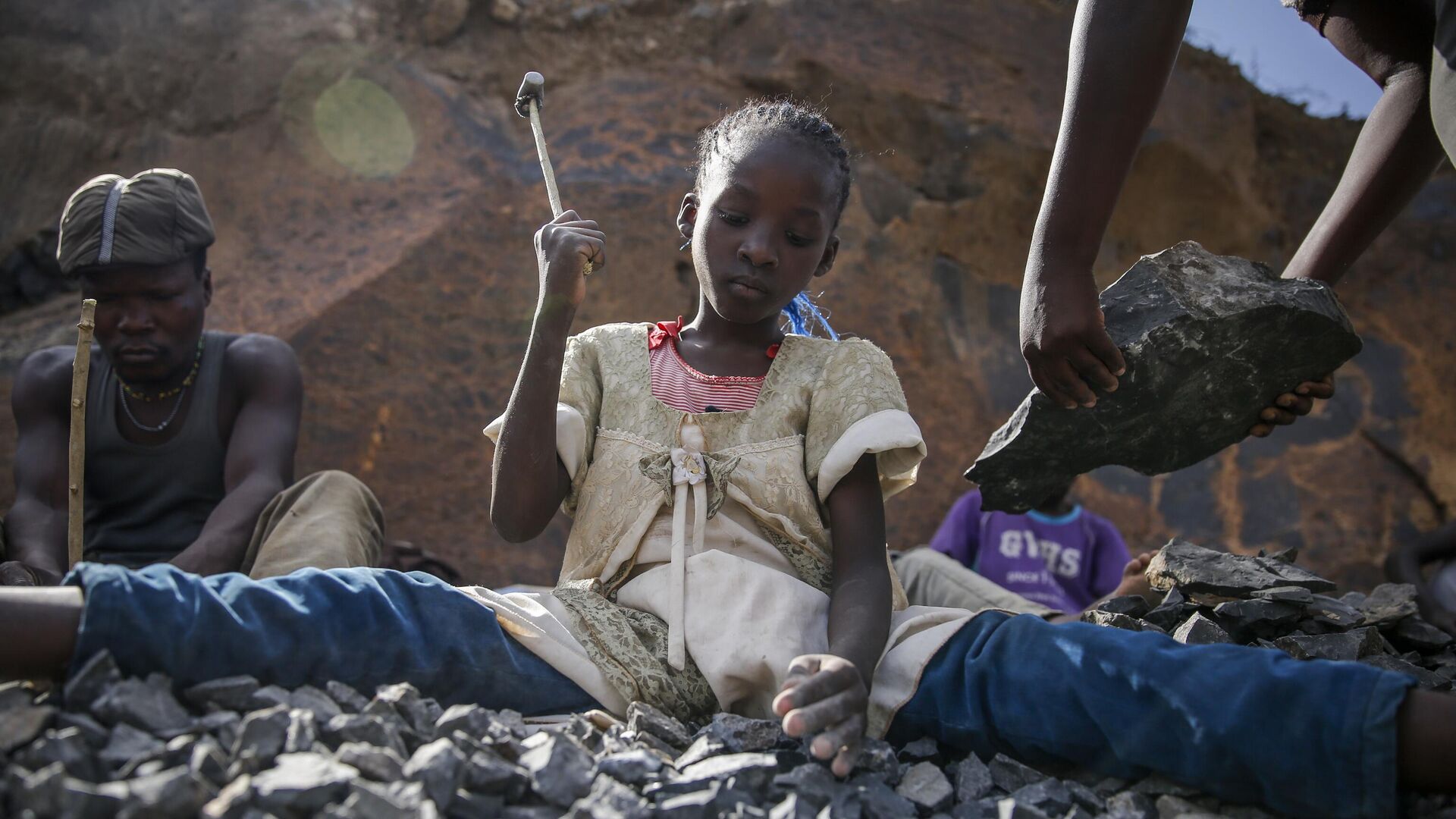https://en.sputniknews.africa/20240612/combating-child-labor-in-africa-a-multifaceted-challenge-requiring-a-balanced-approach-1067020677.html
Combating Child Labor in Africa: A Multifaceted Challenge Requiring a Balanced Approach
Combating Child Labor in Africa: A Multifaceted Challenge Requiring a Balanced Approach
Sputnik Africa
The World Day Against the Exploitation of Child Labor is observed annually on June 12. This day brings together governments, employers' and workers'... 12.06.2024, Sputnik Africa
2024-06-12T19:15+0200
2024-06-12T19:15+0200
2024-06-13T10:47+0200
central africa
east africa
west africa
southern africa
north africa
child labor
children
africa in details
africa insight
conflict
https://cdn1.img.sputniknews.africa/img/07e8/06/0c/1067020913_0:0:3072:1728_1920x0_80_0_0_d479178ccf60f4482817f9f1f866892a.jpg
The prevalence of child labor in Africa is alarming, and there is a need for a comprehensive approach to combat this issue, Isabel Magaya, Manager for the Children and the Law Programme at the African Child Policy Forum (ACPF), said on World Day Against Child Labor, marked annually on June 12.In an interview with Sputnik Africa, Magaya shed light on the complex dynamics of child labor on the continent, noting the disproportionate impact on girls, particularly in the hidden realms of domestic work.Magaya also highlighted the prevalence of child labor in key sectors like agriculture, fishing, mining, and construction.According to the children's rights expert, the root causes of child labor are multifaceted and vary across regions, but poverty remains a major driver, forcing children to work to support themselves or their families.The impact of conflict, particularly in regions like the Sahel, East Africa, and Central Africa, further exacerbates the issue, forcing children out of school and into labor to survive.Climate change is also a growing concern, with limited access to natural resources increasing children's vulnerability to exploitation. "Children on migratory paths, internally displaced, or displaced due to climate-related reasons are at high risk of engaging in child labor," Magaya warned.The ACPF official also emphasized the urgent need for strengthening social protection systems for children.Magaya highlighted the prevalence of the worst forms of child labor, including slavery, trafficking, debt bondage, and forced labor, in various parts of the continent. "If we look at West Africa, we have child trafficking for labor in agriculture and domestic work. If we look at Central Africa, we see a lot of children being trafficked to be used in mines for mining, as well as to be used in armed conflict."The ACPF representative strongly advocated for strengthening legal frameworks and law enforcement to address this issue effectively. According to her, the fight against child labor in Africa faces significant challenges.Magaya believes education is key to safeguarding children from exploitation. She explained, "We need to improve access to education, quality education for children. If children are not in the streets, if children are not idle, they're not susceptible to be used or trafficked, or kidnapped. So schools provide a safe space for children."She emphasized the importance of community awareness campaigns to educate parents and communities about children's rights, the value of education, and the long-term consequences of child labor.Magaya emphasized the critical role of multinational corporations sourcing raw materials in Africa in addressing child labor within their supply chains. She highlighted the importance of conducting due diligence, identifying and mitigating risks, and implementing robust monitoring and evaluation systems to ensure compliance with legal requirements.Navigating the intersection of cultural norms and child labor presents a unique challenge. While some cultures view certain forms of child labor as a means of learning responsibilities, Magaya underscored the importance of a balanced approach that respects cultural norms while safeguarding children's rights.
https://en.sputniknews.africa/20240612/global-conflict-deaths-reach-30-year-high-driven-by-complex-overlapping-wars-report-reveals-1067017323.html
https://en.sputniknews.africa/20240522/new-evidence-fuels-dr-congos-claims-of-apples-blood-minerals-supply-chain-1066687063.html
central africa
east africa
west africa
southern africa
north africa
Sputnik Africa
feedback@sputniknews.com
+74956456601
MIA „Rossiya Segodnya“
2024
Muhammad Nooh Osman
https://cdn1.img.sputniknews.africa/img/07e7/04/0a/1058467512_0:0:1280:1280_100x100_80_0_0_ec723833bcbfcaed2e21952965ad99e4.jpg
Muhammad Nooh Osman
https://cdn1.img.sputniknews.africa/img/07e7/04/0a/1058467512_0:0:1280:1280_100x100_80_0_0_ec723833bcbfcaed2e21952965ad99e4.jpg
News
en_EN
Sputnik Africa
feedback@sputniknews.com
+74956456601
MIA „Rossiya Segodnya“
Sputnik Africa
feedback@sputniknews.com
+74956456601
MIA „Rossiya Segodnya“
Muhammad Nooh Osman
https://cdn1.img.sputniknews.africa/img/07e7/04/0a/1058467512_0:0:1280:1280_100x100_80_0_0_ec723833bcbfcaed2e21952965ad99e4.jpg
central africa, east africa, west africa, southern africa, north africa, child labor, children, africa in details, africa insight, conflict, poverty, interview
central africa, east africa, west africa, southern africa, north africa, child labor, children, africa in details, africa insight, conflict, poverty, interview
Combating Child Labor in Africa: A Multifaceted Challenge Requiring a Balanced Approach
19:15 12.06.2024 (Updated: 10:47 13.06.2024) Muhammad Nooh Osman
Writer/Editor
The World Day Against the Exploitation of Child Labor is observed annually on June 12. This day brings together governments, employers' and workers' organizations, civil society, and millions of people around the world to highlight the plight of child laborers and what can be done to help them.
The prevalence of child labor in Africa is alarming, and there is a need for a comprehensive approach to combat this issue,
Isabel Magaya, Manager for the Children and the Law Programme at the African Child Policy Forum (ACPF), said on
World Day Against Child Labor, marked annually on June 12.
In an interview with Sputnik Africa, Magaya shed light on the complex dynamics of child labor on the continent, noting the disproportionate impact on girls, particularly in the hidden realms of domestic work.
"There's a very strong, gendered aspect to child labor," she stated, noting that while more boys are involved in child labor, girls are often engaged in domestic work, which is hidden, making it difficult to accurately assess the true numbers.
Magaya also highlighted the prevalence of child labor in key sectors like agriculture, fishing, mining, and construction.
According to the children's rights expert, the root causes of child labor are multifaceted and vary across regions, but poverty remains a major driver, forcing children to work to support themselves or their families.
"High levels of poverty are a key driver," Magaya said. "When children lack adult care, they have to fend for themselves."
The impact of conflict, particularly in regions like the Sahel, East Africa, and Central Africa, further exacerbates the issue, forcing children out of school and into labor to survive.
Climate change is also a growing concern, with limited access to natural resources increasing children's vulnerability to exploitation. "Children on migratory paths, internally displaced, or displaced due to climate-related reasons are at high risk of engaging in child labor," Magaya warned.
The ACPF official also emphasized the urgent need for strengthening social protection systems for children.
"Most of our African governments do not provide enough social protection for children, especially in light of the high levels of poverty," she said.
Magaya highlighted the prevalence of the worst forms of child labor, including slavery, trafficking, debt bondage, and forced labor, in various parts of the continent. "
If we look at West Africa, we have child trafficking for labor in agriculture and domestic work. If we look at Central Africa, we see a lot of children being trafficked to be used in mines for mining, as well as to be used in armed conflict."
The ACPF representative strongly advocated for strengthening legal frameworks and law enforcement to address this issue effectively. According to her, the fight against child labor in Africa faces significant challenges.
"Sometimes the laws are there, but implementation on the ground is incredibly difficult. So one of my biggest recommendations is that we need to improve our law enforcement. And the theme for this year's Child Labor Day is that we have to honor our commitments," Magaya told Sputnik Africa.
Magaya believes education is key to safeguarding children from exploitation. She explained, "We need to improve access to education, quality education for children. If children are not in the streets, if children are not idle, they're not susceptible to be used or trafficked, or kidnapped. So schools provide a safe space for children."
She emphasized the importance of community awareness campaigns to educate parents and communities about children's rights, the value of education, and the long-term consequences of child labor.
"The barriers are multifaceted," Magaya explained. "Sometimes it's ignorance, sometimes it's corruption, and sometimes the laws themselves are outdated or poorly implemented."
Magaya emphasized the critical role of multinational corporations sourcing raw materials in Africa in addressing child labor within their supply chains. She highlighted the importance of conducting due diligence, identifying and mitigating risks, and implementing robust monitoring and evaluation systems to ensure compliance with legal requirements.
"Multinationals need to be intentional about addressing child labor," she stressed. "They need to put in place sustainable business practices that specifically aim at protecting children."
Navigating the intersection of cultural norms and child labor presents a unique challenge. While some cultures view certain forms of child labor as a means of learning responsibilities, Magaya underscored the importance of a balanced approach that respects cultural norms while safeguarding children's rights.
"We need to distinguish between harmful child labor and beneficial, age-appropriate work for children," she concluded. "Let us make sure that the rights that children have are not only rights on paper, but they're actually translating to children's lived realities and improving their situation. So my parting words would be that child labor in Africa is a hindrance to the Africa we want."




